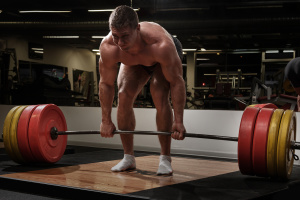Improve Your Lifts by Up to 20%
 I know that I frequently discuss the fact that I believe that it is important to lift weights forcefully when performing each repetition. The reason I emphasize this so much is that it can make a big difference in your lifting performance. If you want to lift a lot of weight, learn to lift the weights explosively and forcefully while maintaining excellent exercise form.
I know that I frequently discuss the fact that I believe that it is important to lift weights forcefully when performing each repetition. The reason I emphasize this so much is that it can make a big difference in your lifting performance. If you want to lift a lot of weight, learn to lift the weights explosively and forcefully while maintaining excellent exercise form.
Apply Maximum Force Regardless of the Weight
Many lifters only exert maximum force into a lift when they are lifting near maximum weights. However, if you learn to lift lighter weights forcefully and explosively, you will find that they can add to your strength as well. A lot of people take a vacation when they lift weights that are only moderately heavy. They push or pull in a casual half-hearted manner. They are wasting an opportunity to improve their strength on each and every rep of the workout when they do so.
CAT or Compensatory Acceleration Training
Fred Hatfield is one of the greatest squatters in the history of powerlifting. He came up with the term CAT which stands for Compensatory Acceleration Training. It simply means to lift with full force through the entire range of motion. The top of the range of a motion in a lift tends to be easier than the bottom, so lifters often exert a lot of force at the start of the lift, but ease up at the end of a repetition. However, when using CAT, you lift with full effort and accelerate all the way through the whole range of motion from start to finish.
The Difference Explosive Training Can Make
Fred Hatfield has said that lifters who don’t use the CAT method of forceful lifting can increase their lifts by as much as 20%. Brandon Lilly can bench over 500 pounds and gives a real life example of how much it helped him when he finally learned to push all the way through the very end of the full range of motion when benching. Both Fred and Brandon talk about this in the videos.
Carefully Work Your Way into it
As much as explosive training can help you gain strength, it should be preceded by mastering each lift with excellent form and increasing the speed of the lift according to your ability to maintain good form and remain injury free. Make sure your muscles, joints, tendons and ligaments can withstand forceful lifting and work your way into it before engaging in this type of lifting.
Perhaps you have found it useful to do slow controlled reps and don’t like fast explosive reps. If that’s the case, I would suggest continuing with slow controlled reps, but doing some of your training with explosive reps as well to get benefit that it can provide. Best of training to you.
